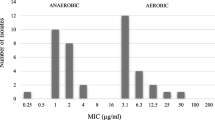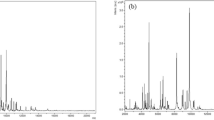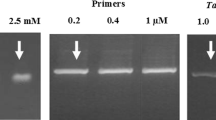Abstract
Twelve metronidazole-resistant and twelve metronidazole-susceptible strains ofTrichomonas vaginalis were tested for the presence of dsRNA. Three resistant and five susceptible strains were found to contain dsRNA which indicated that metronidazole resistance does not correlate with the absence of dsRNA. Electron microscopy showed the homogenates of all dsRNA -positive strains to contain virus-like particles 32 –38 nm in diameter, while no such particles were found in the dsRNA-negative strains. A mutual relationship between the dsRNA and virus-like particles seems to exist.
Similar content being viewed by others
References
Diamond L.S.: The establishment of various trichomonads of animals and man in axenic culture.J. Parasitol. 43, 488–490 (1957).
Flegr J., Čerkasov J., Kulda J., Štokrová J.: Occurrence of double stranded RNA inTrichomonas vaginalis, p. 43 in Abstr. Internat. Symp. Trichomonads and Trichomoniasis, Prague 1985.
Flegr J., Čerkasov J., Čerkasovová A., Kulda J., Štokrová J.: Double stranded RNA inTrichomonas vaginalis, pp. in Trichomonads and Trichomoniasis, Part 1 (J. Kulda, J. Čerkasov, eds.).Acta Universitatis Carolinae Biologica, in press 1987.
Forsgren A., Forsmann L.: Metronidazole resistantTrichomonas vaginalis.Brit. J. Vener. Dis. 55, 351–353 (1979).
Frank H., Schwarz H., Graf T., Schäfer W.: Properties of mouse leukemia viruses. XV. Electron microscopic studies on the organization of friend leukemia virus and other mammalian C-type viruses.Z. Naturforsch. 33c, 124–138 (1978).
Kulda J., Vojtěchovská M., Tachezy J., Demeš P., Kuncová E.: Metronidazole resistance ofTrichomonas vaginalis as a causa of treatment failure in trichomoniasis.Brit. J. Vener. Dis. 58, 394–399 (1982).
Maniatis T., Fritsch E. F., Sambrook J.:A Laboratory Manual, Molecular Cloning. Cold Spring Harbor Laboratory, Cold Spring Harbor, New York 1983.
Mattern C.F., Diamond L.S., Daniel W.A.: Viruses ofEntamoeba histolytica. II. Morphogenesis of the polyhedral particle (ABRM2-HK-9) → HB-301 and filamentous agent (ABRM)2 → HK-9.J. Virol. 9, 342–358 (1972).
Meingassner J.G., Thurner J.: Strain ofTrichomonas vaginalis resistant to metronidazole and other 5-nitroimidazoles.Antimicrob. Agents Chemother. 15, 254–257 (1979).
Meingassner J.G.: Nitroimidazole resistance in trichomonads.Wiad. Parazytol. 29, 151–154 (1983).
Müller M., Meingassner J., Müller W.A., Ledger W.J.: Three metronidazole-resistant strains ofTrichomonas vaginalis from the United States.Am. J. Obstet. Gynecol. 138, 808–812 (1980).
Ramig R.F., Cross R.K., Fields B.N.: Genome RNAs and polypeptides of reovirus serotypes 1, 2, and 3.J. Virol. 22, 726–733 (1977).
Schuster F.L., Durnebache T.H.: Formation of bodies associated with virus-like particles in the amoeboflagellateNaegleria gruberi.J. Ultrastructure Res. 36, 659–668 (1971).
Ushiyama R.: Viruses in fungi and eukaryotic algae: their possible origin and evolution.Microbiol. Sciences 2, 181–184 (1985).
Valent M., Demeš P., Štťková D., Baloghová E.: Two clinical cases of urogenital trichomoniasis resistant to nitroimidazole derivatives. (In Slovak)Českosl. Gynekol. 50, 696–697 (1985a).
Valent M., Demeš P., Štětková D.: Unsuccessful treatment of a patient with urogenital trichomoniases, caused by resistance of the agent to nitroimidazole derivatives. (In Slovak)Bratislavské Lékar. Listy 83, 156–161 (1985b).
Wang A.L., Wang C.C.: A linear double stranded RNA inTrichomonas vaginalis.J. Biol. Chem. 260, 3697–3702 (1985).
Zasloff M., Ginder G.D., Felsfeld G.: A new method for the purification and identification of covalently circular DNA molecules.Nucl. Acids Res. 5, 1139–1152 (1978).
Author information
Authors and Affiliations
Additional information
After this paper had been accepted for publication the occurrence of virus-like particles in dsRNA-positive trichomonads was reported by others (Wang A.L., Wang C.C.: The double stranded RNA inTrichomonas vaginalis may originate from virus-like particles.Proc. Nat. Acad. Sci. USA 83, 7956–7961, 1986).
Rights and permissions
About this article
Cite this article
Flegr, J., Čerkasov, J., Kulda, J. et al. The dsRNA ofTrichomonas vaginalis is associated with virus-like particles and does not correlate with metornidazole resistance. Folia Microbiol 32, 345–348 (1987). https://doi.org/10.1007/BF02877224
Received:
Issue Date:
DOI: https://doi.org/10.1007/BF02877224




